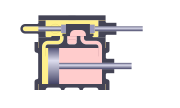
D slide valve
Encyclopedia
.jpg)
.jpg)
Rectilinear
Rectilinear may refer to:* Rectilinear grid, a tessellation of the Euclidean plane* Rectilinear lens, a photographic lens* Rectilinear locomotion, a form of animal locomotion* Rectilinear polygon, a polygon whose edges meet at right angles...
valve used to control the admission of steam into, and emission of exhaust from, the cylinder of a steam engine.

Use
In the 19th century, most steam locomotives used slide valves to control the flow of steam into and out of the cylinderCylinder (steam locomotive)
The cylinders of a steam locomotive are the components that convert the power stored in the steam into motion.Cylinders may be arranged in several different ways.-Early locomotives:...
s. In the 20th century, slide valves were gradually superseded by piston valves, particularly in engines using superheated
Superheater
A superheater is a device used to convert saturated steam or wet steam into dry steam used for power generation or processes. There are three types of superheaters namely: radiant, convection, and separately fired...
steam. There were two reasons for this:
- With piston valves, the steam passages can be made shorter. This reduces resistance to the flow of steam and improves efficiency.
- It is difficult to lubricateLubricationLubrication is the process, or technique employed to reduce wear of one or both surfaces in close proximity, and moving relative to each another, by interposing a substance called lubricant between the surfaces to carry or to help carry the load between the opposing surfaces. The interposed...
slide valves adequately in the presence of superheated steam.
Murdoch's D slide valve
.jpg)
William Murdoch
William Murdoch was a Scottish engineer and long-term inventor.Murdoch was employed by the firm of Boulton and Watt and worked for them in Cornwall, as a steam engine erector for ten years, spending most of the rest of his life in Birmingham, England.He was the inventor of the oscillating steam...
and patented in 1799. It is named after the hollow central D-sectioned piston.
This valve worked by "connecting the upper and lower valves so as to be worked by one rod or spindle, and in making the stem or tube which connects them hollow, so as to serve for an induction pipe to the upper end of the cylinder." This allowed two valves to do the work of four.
The above description (referring to upper and lower valves) clearly relates to an engine with a vertical cylinder, such as a beam engine
Beam engine
A beam engine is a type of steam engine where a pivoted overhead beam is used to apply the force from a vertical piston to a vertical connecting rod. This configuration, with the engine directly driving a pump, was first used by Thomas Newcomen around 1705 to remove water from mines in Cornwall...
. Where the cylinders are horizontal, as in a steam locomotive
Steam locomotive
A steam locomotive is a railway locomotive that produces its power through a steam engine. These locomotives are fueled by burning some combustible material, usually coal, wood or oil, to produce steam in a boiler, which drives the steam engine...
, the valves would be side-by-side.
Balanced slide valve
The balanced slide valve was invented by the ScottishScotland
Scotland is a country that is part of the United Kingdom. Occupying the northern third of the island of Great Britain, it shares a border with England to the south and is bounded by the North Sea to the east, the Atlantic Ocean to the north and west, and the North Channel and Irish Sea to the...
engineer Alexander Allan
Alexander Allan (locomotive engineer)
Alexander Allan was a Scottish mechanical engineer. He was born at Montrose, Angus, in 1809 and died on 2 June 1891.From 1843 to 1853 he was Works Manager at the Crewe Works of the Grand Junction Railway, later London and North Western Railway, under Francis Trevithick. Here he was responsible for...
. It was not much used in the UK but, at one time, had great popularity in the USA. It gave some of the advantages of a piston valve to a slide valve by relieving the pressure on the back of the valve, thus reducing friction and wear.
See also
- Valve gearValve gearThe valve gear of a steam engine is the mechanism that operates the inlet and exhaust valves to admit steam into the cylinder and allow exhaust steam to escape, respectively, at the correct points in the cycle...
- piston valve
- Poppet valvePoppet valveA poppet valve is a valve consisting of a hole, usually round or oval, and a tapered plug, usually a disk shape on the end of a shaft also called a valve stem. The shaft guides the plug portion by sliding through a valve guide...
- Sleeve valveSleeve valveThe sleeve valve is a type of valve mechanism for piston engines, distinct from the usual poppet valve. Sleeve-valve engines saw use in a number of pre-World War II luxury cars and in USA in the Willys-Knight car and light truck...
- Corliss valve

